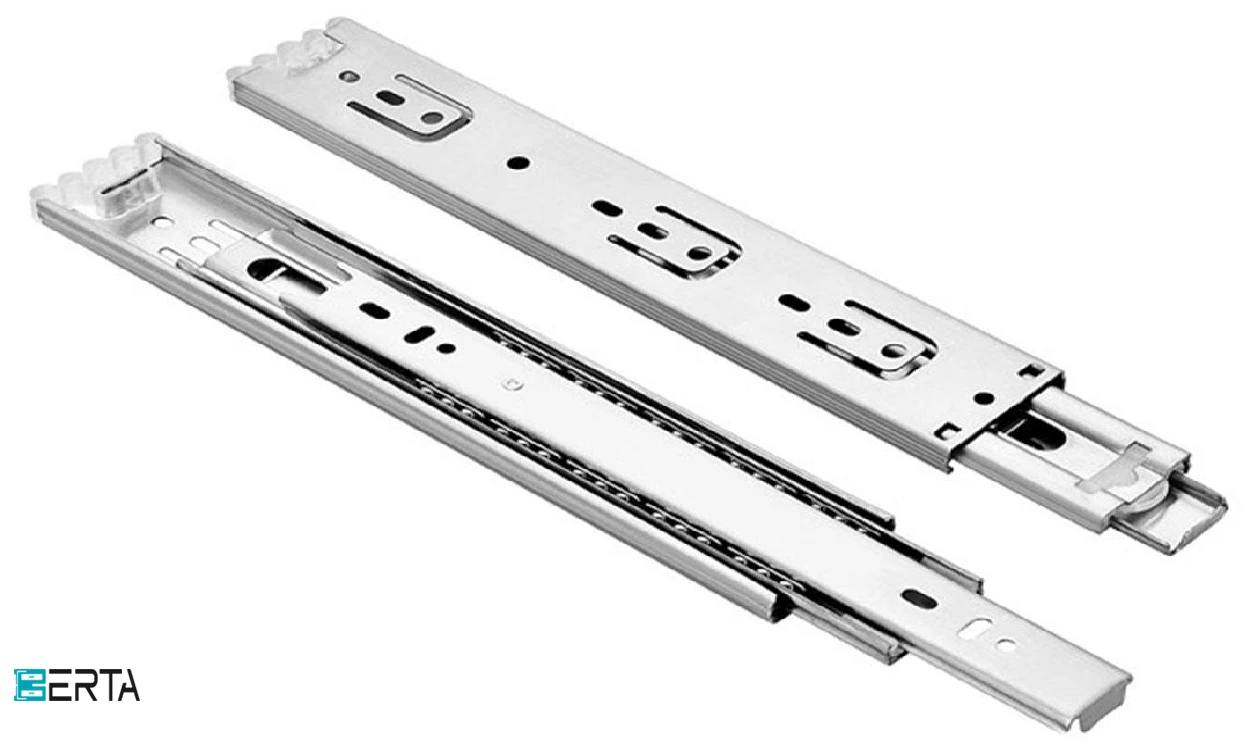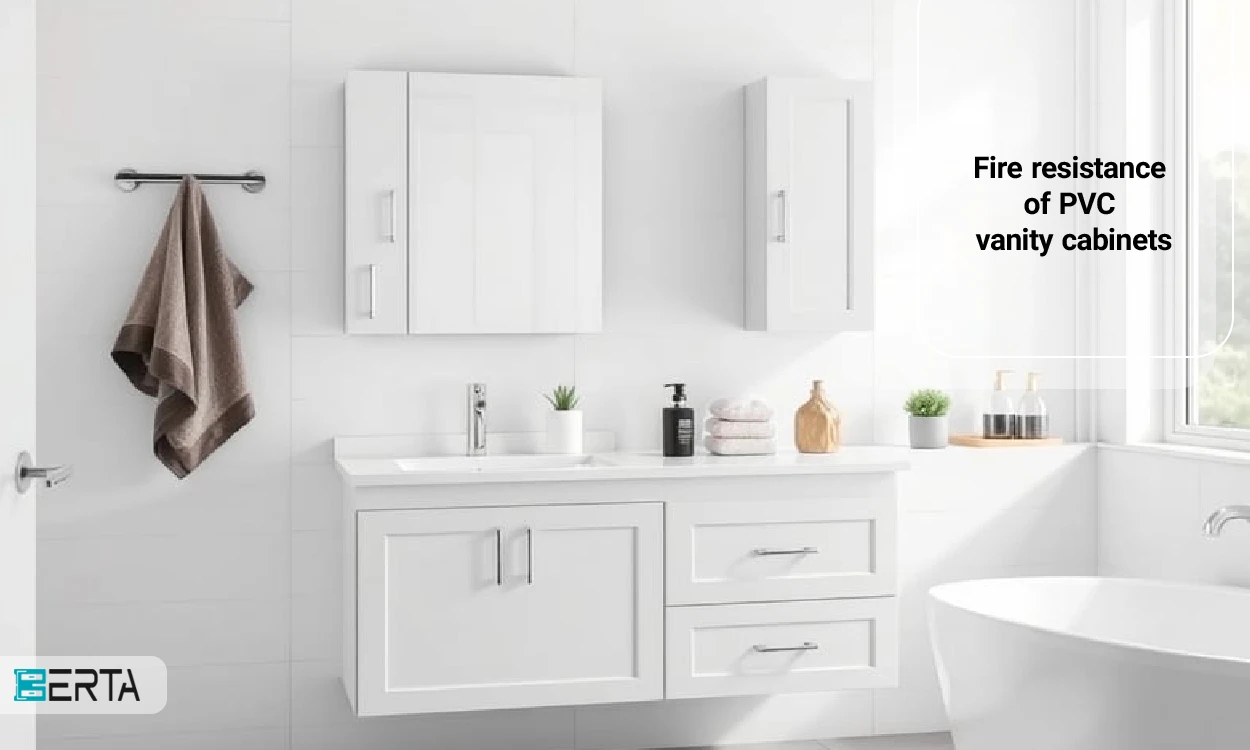Cabinets and wardrobes are key elements of our modern life, and especially in bathrooms, vanities play an important role in the beauty and efficiency of the space. Vanity cabinets not only help organize and store personal and sanitary items but also add beauty to the environment with their diverse designs. One of the vital components of these cabinets are drawers that provide easy access to the contents in the form of open boxes. Today, moving drawers is done with the help of rails that come in different types and, in addition to facilitating movement, also help reduce noise when opening and closing the drawer. In this article, we will examine the types of sliding rails and their installation methods so that you can choose and use these fittings with more awareness.
Types of Sliding Rails
A drawer rail is one of the main components in the design and construction of cabinets and drawers, which helps the drawers move easily and smoothly. Here, we will examine the types of rails.
Roller Sliding Rail
A roller sliding rail is one of the oldest and most basic types of cabinet rails. These rails usually consist of two pulleys and two metal strips made of iron. These strips are also known as white rails due to the white color of the furnace that is covered on them.
Roller slide rail specifications
1- Weight capacity: Roller rails usually have a low weight capacity and can withstand a maximum of 15 kg. This feature makes them suitable for use in light and shallow drawers.
2- Easy installation: Installing these rails is very simple and does not require special expertise. One part of the rail is connected to the cabinet body and the other part to the bottom of the drawer body.
3- How to move: The drawer moves on these rails through the pulleys and wheels in it. The bearings attached to the moving part that are installed on the rail grooves act like small wheels and allow the drawer to move easily.
4- Price: Roller rails are usually less expensive than other types of rails, making them an economical option for cabinets.
5- Dimensions: The width of these rails is usually about two centimeters, and their length varies between 30 and 50 centimeters in the market.

Ball or telescopic slide rail
A ball or telescopic slide rail is one of the most widely used and popular types of rails in the cabinetmaking industry. These rails are used in many drawers and cabinets due to their unique features and excellent performance. Below, we will take a closer look at these types of rails.
Specifications of ball or telescopic slide rail
1- Structure and raw materials: Ball rails are usually made of thick iron sheets, which increases their strength and durability. Due to the high quality of the raw materials, these rails can easily withstand heavy loads.
2- Movement mechanism: The movement mechanism of ball rails is made possible by two metal strips and the balls inside the strips. These balls ensure smooth movement of the drawer. Also, these rails have a lock that prevents the drawer from completely coming out of the work. To fully remove the drawer, simply move the latches up or down.
3- Dimensions and weight capacity: Ball rails are available in two types, wide and narrow, and with lengths of 20 to 100 centimeters. These rails can withstand up to 75 kilograms of weight, which makes them suitable for heavy drawers.
Types of ball or telescopic sliding rails
Ball rails are divided into two main types:
- Two-piece: Suitable for drawers with shallow depth and low weight capacity.
- Three-piece: These types of rails can be used in different dimensions and have a higher weight capacity. Drawers with three-piece ball rails stop slightly at the end of their path and are slowly guided inward, which is why these rails are also called braked rails.
Classification of ball or telescopic sliding rails based on the type of closure
Ball rails can also be divided into the following three types:
- Simple: Consists of two metal strips and internal balls that prevent the drawer from being completely pulled out.
- Soft-closing: There are pumps at the end that slow down the closing speed of the drawer and prevent the closing sound.
- Pressure or magnetic: Due to their special design, these rails can be used without the need for a handle and have a very smooth movement.

Tandem Sliding Rail
Tandem sliding rail is one of the most advanced and popular types of drawer rails in the cabinet industry, which has attracted the attention of cabinet designers and manufacturers due to its unique features and high efficiency. Below, we will take a closer look at this type of rail.
Tandem Sliding Rail Specifications
1- Operating Mechanism: Tandem rails are equipped with a pump system that allows them to withstand high weight. These rails automatically adjust the closing speed of the drawer, so that even with heavy pressure, the drawer closes slowly. This feature is known as the soft-close system and helps prevent noise when the drawer is closed.
2- Design and Structure: Tandem rails have a modern and beautiful design. These rails are usually slim and shiny and are made of high-quality materials. The width of these rails is about 12.8 mm. The harmonious design and beautiful harmony of these rails make them an attractive option for modern cabinets.
3- Installation and compatibility: Tandem rails are easy to install and can be used for any type of door and drawer. These rails are designed in such a way that they do not create any restrictions on the dimensions of the drawer. Their installation is such that the rail body is placed on both sides of the drawer and the drawer can be installed in different dimensions (from 30 to 70 cm units).
Types of tandem sliding rails
Tandem rails are divided into two types:
- Fully opening: In this type, the drawer is completely removed from the housing.
- Semi-opening: In this type, the drawer does not open completely.

Types of Drawer Rail Installation Methods
Drawer rail installation is one of the important steps in the construction and design of cabinets and wardrobes. Drawer rails are installed in three main methods: side, center, and bottom, each with its characteristics and advantages. We will examine these installation methods below.
1- Side method
In this method, drawer rails are installed from side to side. This type of installation has the following advantages:
- High strength: Side rails are stronger and can withstand more weight because they are installed on both sides of the drawer.
- Smooth movement: This method allows the drawer to be easily and without problems.
- Better access: With this method, the drawer can be opened all the way and provides a wide view of the contents inside, which makes it easier to use the items inside the drawer.
2- Center method
In center installation, a rail is installed below the drawer and in its middle. The features of this method include:
- Less use of rails: This method suits users who want to use fewer rails in the drawer.
- Suitable for light drawers: This type of rail is usually used for light and light drawers.
3- Undermount method
The under-mount installation model is designed so that the drawer rail is not exposed and at the same time has a high weight-bearing capacity. The features of this method include:
- Concealed rail: Drawer rails are installed on the sides of the drawer from below, which keeps the rails hidden from view.
- Medium weight bearing: These rails are usually suitable for drawers that are medium weight and can work well.
Conclusion
Finally, choosing the right rail for drawers not only affects the functionality and efficiency of the cabinets but also helps to enhance the beauty and orderliness of the interior space. From traditional roller rails to modern ball and tandem rails, each has its unique features and benefits that can be selected according to your needs and taste. Also, different installation methods such as side, center, and bottom allow you to choose the best option according to the design and intended use. By reviewing these tips, you can equip your cabinets and wardrobes efficiently and beautifully and make the most of your space.





17938.jpg)
 Whatsapp
Whatsapp  Telegram
Telegram 





